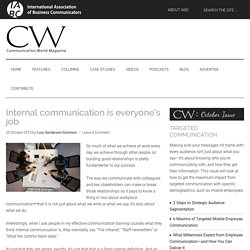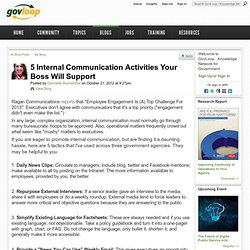

How to add some Oscars’ sparkle to your internal communications. Internal communication is everyone's job. So much of what we achieve at work every day we achieve through other people, so building good relationships is pretty fundamental to our success.

The way we communicate with colleagues and key stakeholders can make or break those relationships so it pays to know a thing or two about workplace communication—that it is not just about what we write or what we say, it’s also about what we do. Interestingly, when I ask people in my effective communication training courses what they think internal communication is, they inevitably say “The intranet,” “Staff newsletters” or “What the comms team does.” It’s not that they are wrong, exactly. It’s just that that is a fairly narrow definition. Techniques for Improving Employee Communication. When you notice that business is a bit slow, it might be due to bad communication between employees.

However, with simple exercises and trainings, you can help not only mediate the problem but fix it for good. 7 PR Tips for Employee CommunicationsPR News. A strong internal communications team is essential to a company's success.

Employees need to be kept informed of their organization's activities and direction in order to feel secure about their role and their contribution to the team. The internal comms folks are the gatekeepers of that information, and for them to effectively do their job, they need to rely on some solid PR tactics. Alanna Vitucci, director of communications and alumni relations at Northcentral University in Arizona, shares some tips that internal communicators can learn from PR pros.
Subject lines are headlines. You’ve worked on the quarterly message from your CEO for weeks. For more information on internal communications, see PR News' Book of Employee Communications, on sale now. Follow Northcentral University: @NorthcentralU. How to communicate like navy seals and increase profits. High-performance teams need exemplary communication to be successful.

Good communication is critical for any relationship to flourish, overcome adversity, and survive long-term. When going through Navy SEAL training, students are taught to move, shoot, and communicate in stressful environments. Good communication builds trust and drives the team forward with a shared sense of purpose. When I became an entrepreneur I quickly realized that communication is equally as important for business partnerships and companies as a whole to thrive. This is true for small businesses all the way to global corporations. My digital marketing agency has 100 employees across two offices and we still face issues with communication.
When a company's internal communications are poor, it erodes trust. One of our sayings in the SEAL teams is "pass the word. " 10 Ways to Improve Internal Communication. Optimize Internal Communication for Maximum Impact - The Resonate Group, Inc. Internal communication affects your ministry’s external impact more dramatically than you might realize.

If you want what emerges on the outside to be compelling, then you should strengthen your internal communication by practicing healthy habits. Here are a few ways to optimize internal communication, so you will have greater external impact: 1. Formulate and ask a lot of thoughtful questions To fully understand (and appreciate) the ministry objectives of others, you’ve got to ask some really great questions—questions which stir thinking and stimulate the right discussions. 2. You can pivot your conversations toward a more productive destination by simply reframing the questions which are causing you to hang up. 3.
If you find yourself in complex conversations where language is either hard to understand or where certain terms create frustration, you might need to work on your dictionary. 4. 5 Tips For Strategic Employee Communication. Most of us spend weeks or months pouring over your social media, print and video campaign for the new product your company is pushing.

Stay Relevant, Current and on Course to be Respected as an Internal Communicator « INTRASKOPE – INTERNAL COMMUNICATION VIEWPOINT FROM INDIA. Here is my follow-up to the post -Why are Internal Communicators Always on the Ball?

Prakash is probably right – there is a lot of difference between what other teams do in comparison to his team. That should make him proud instead of feeling demoralized. However, that is easier said than done. To put things in perspective, Raju needs to ask him the following questions: The Top 10 Songs about When Employee Engagement and Communication Fails! - The Dialogue Zone. 5 Internal Communication Activities Your Boss Will Support. Ragan Communications reports that "Employee Engagement Is (A) Top Challenge For 2013": Executives don't agree with communicators that it's a top priority ("engagement didn't even make the list.

") In any large, complex organization, internal communication must normally go through many bureaucratic hoops to be approved. Also, operational matters frequently crowd out what seem like "mushy" matters to executives. If you are eager to promote internal communication, but are finding it a daunting hassle, here are 5 tactics that I've used across three government agencies. They may be helpful to you: 1. 2. 3. 4. 5. Internal Communications - Free PR Advice and Tips Checklist. Value of Employee Communication Sessions. By Jay Delahousay, Demand Media Source: Despite the many ways to pass information in the workplace — email, social media, phone, text or via the company intranet — inadequate communication between managers and employees exists.

Employees need guidance from their supervisors, and management needs input from the entire team in order for the company to succeed. To help foster an open and honest culture, many companies host communication sessions that can provide measurable benefits to all employees. Definition An employee communication session is a give-and-take opportunity where employees can air their concerns and where management can share what’s happening in the company. Facilitates Dialogue When a company is multifaceted, one department might not be aware of the strategic goals of another part of the business, — or information trickles upward, but not downward. Inspires Involvement and Loyalty Builds Trusting Relationships Minimizes Gossip.